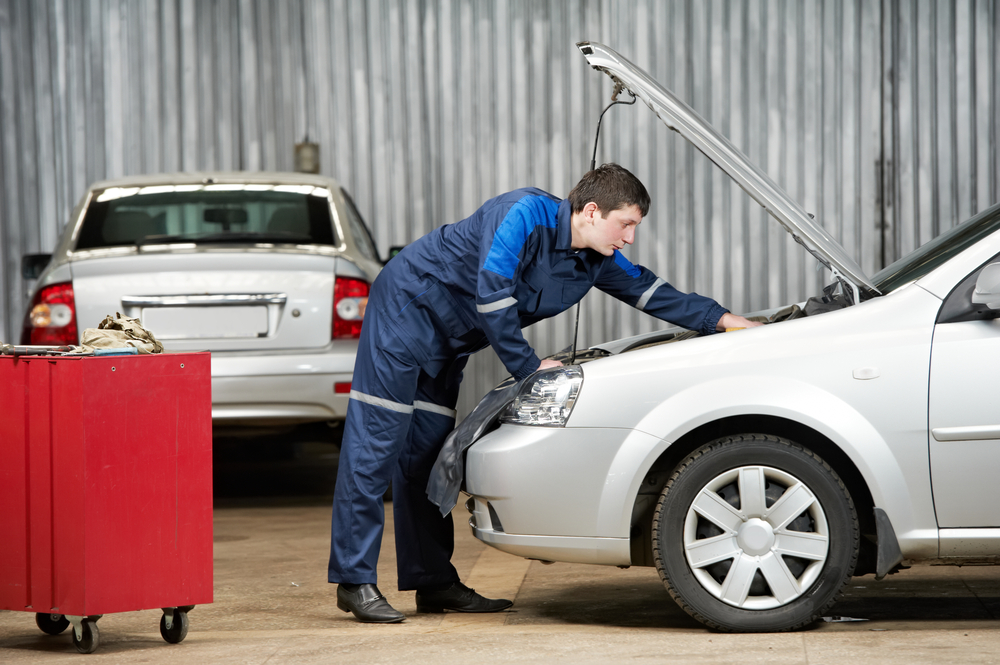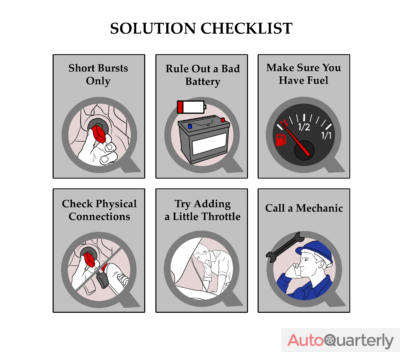We’ve all been there. You wake up, stretch, have a cup of coffee, and sit down in your car to drive to work. You put the key into the ignition, and the car keeps turning over but just doesn’t start. You get an irritating churning and grinding sound, but you never get that satisfying pop and purr that you need.
If you’ve experienced this, or worse, you’re experiencing this right now, then this article is for you. In fact, if you need to diagnose the problem immediately, jump down to our solution checklist here. Otherwise, we’ll break down what a normal startup procedure looks like, how the startup can fail, and how to test the systems involved.
The Normal Startup Procedure
There are a few different motor types found on the road today. Since electric motors don’t have a crank, we will focus on the two largest groups: gas and diesel.
Gas
Gas engines use high-octane petroleum as fuel. Under normal circumstances, an engine needs four things to run: air, fuel, ignition, and compression. When the vehicle is running, the piston moves down and creates a vacuum. That vacuum pulls in the air that gets mixed with fuel. Then the piston moves up, compressing the air and fuel, until the spark plug fires and ignites the mixture, which pushes the piston down.
Those are the first three strokes of a four-stroke engine. The final stroke is simply the piston moving back up and pushing the exhaust gases out. Just remember, “suck, squeeze, bang, blow.” If you prefer a visual reference, old auto shop cartoons are the best way to learn how an engine works. So when a car doesn’t turn over, it’s probably something is going wrong in one of these steps.
Starting a Gas Engine
When the engine is off, it isn’t moving and thus isn’t pulling in any air. The starter, which is the sound you hear when you crank an engine, is an electric motor that powers the motor long enough to start the combustion cycle. It uses battery power to move the pistons by spinning the crankshaft.
You had to do this on very old cars by physically spinning the crankshaft using a big wrench, but now the starter does the work. Once the crankshaft is spinning, initiating the combustion cycle, all the other systems come online. The fuel pump draws fuel, the spark plugs fire, and the alternator takes over from the battery.
Diesel
Diesel engines use diesel instead of pump gas to run. The four strokes of a diesel engine are largely the same as a gas motor; there is only one notable difference. Diesel motors do not have spark plugs. Instead, the pressure of the downward force of the piston is enough to ignite the fuel/air mixture.
To help the starting process, diesel motors have glow plugs. They are called glow plugs because they glow red hot when energy is applied. By raising the temperature inside the cylinders, you lower the amount of compression needed to ignite the mixture.
Starting a Diesel Engine
The starting sequence of a diesel engine is only slightly different than a gas engine. The biggest difference is the sequence for the operator. If it’s cold or the diesel engine is older, you have to turn the glow plugs on first and wait for them to heat up. Then, once they are hot, you engage the electric starter, and the process can begin.
Common Issues

The good news is that if your car or truck is turning over, it means you probably don’t have a battery or starter problem. If you turn the key and don’t hear anything, it means your battery is toast. Unfortunately, that usually means that one part of the 4-cycle process is not happening. In general, the issues that plague a diesel and a gas motor will be similar. The only big difference is that you can safely rule out spark issues if you have a diesel since they don’t have spark plugs.
There is a possibility that your battery is almost drained, so it has enough juice to turn over but not enough for the engine to actually start up. If this is the case, the start sound will sound different and weaker than normal. If this is the case, you’re in need of a jump start.
Air
Engines need a lot of air to run. If you spend time around people who build up engines, you’ll often hear that “engines are just air pumps.” Usually, even if the car has severe intake issues, it will still start. Modern cars can compensate for wild fluctuations in airflow, and it’s unlikely that an air intake problem is your issue if your car won’t start.
You should still check the air filters and make sure the intake is in good condition. A damaged intake or old, dirty filter can cause your car to start slower and run roughly, so it’s worth it to keep an eye on. But it’s probably not the reason your car won’t start.
Fuel
Fuel issues represent a fairly common reason that a will crank but not start. There are a few reasons that fuel won’t be making it to the cylinders.
- Fuel pump regulator
- Fuel pump issues
- Clogged fuel filter
- Clogged or broken injectors
- Bad fuses or relays
- Out of gas
Testing a Fuel System
To test your fuel system, you will need two things: a multimeter and a fuel pressure tester.
The fuel pressure tester hooks up to your fuel rail and measures the amount of pressure coming from your fuel pump. You will have to look up the fuel pressure standards for your vehicle and test for that pressure. If the pressure is too low, then you have an issue with the pump or filter.
The multimeter is used to test the fuses, relays, and power going to the injectors. A blown fuse can prevent the fuel pump from turning on, which means your engine won’t be getting fuel.
Compression
Compression issues are rare but pose serious problems that can prevent a car from starting. Compression requires an airtight chamber, with one of four main things causing a fail to seal: the piston rings, the valves, the spark plug, or the head gasket. Of the four, a failing head gasket is the most common issue.
Testing the Compression
There are two ways to test compression on an engine. The first is with a simple device called a compression tester. It’s just a length of hose with a pressure gauge on one end, and you can plug it into the spark plug hole to compare the pressures between cylinders.
The other test is called a leak down test. It requires a more specialized tool and a bit more know-how, but it can differentiate between different failed parts. The Mobile oil company has a good write up about leak down tests here if you think you need to perform one.
Spark
Lack of spark is another common issue that will cause a gas motor to fail to start. Modern ignition systems are very robust. A computer tells a coil pack to send a signal directly to the spark plug, which fires. Since a car can continue to run when one or two spark plugs fail, the only way for the entire car to fail to start is an issue that affects the entire system. That often means a bad electrical connection somewhere, which can be found with a multimeter.
Testing for Spark
You can very quickly test an ignition system using a simple spark plug tester. A spark plug tester is just a lightbulb that gets inserted between the spark plug and the plug wire and lights up when it receives voltage. Good quality testers will remain lit, so you can get out and look; otherwise, you might need to recruit another set of eyes.
Distributors
Older vehicles that use distributors and ignition coils can have a host of different problems. Since the distributor and the ignition coil are both single points of failure, either one can be damaged or malfunction to cause the entire vehicle to fail to start.
The distributor is also responsible for the vehicle’s timing. If the timing is off, the spark plugs will fire at the wrong time, and the car won’t run. If your vehicle was manufactured before 1994, it might have a distributor, and you can get better help online by searching vehicle-specific forums or manuals.
Glow Plug Issues
A diesel motor does not have spark plugs, so the problem can’t be with the ignition system. However, bad glow plugs can make starting a diesel much more difficult. It may prevent the vehicle from starting in cold or other sub-optimal conditions.
Testing a glow plug is fairly easy, though. You can read up on how to perform that test here.
Other Issues
There are a handful of other issues that can happen and prevent a car from starting. These issues are a bit harder to diagnose and may need to be looked up in a dedicated service manual on a case by case basis.
- Crash sensors can prevent the fuel pump from running after an accident
- Other sensors like the MAF or MAP can malfunction and cause fuel or spark issues
- The computer can be malfunctioning
- There can be broken wires inside the steering column
- An anti-theft device cut power to the fuel pump
Solution Checklist
Cars tend to fail at inconvenient times. Chances are, if you are experiencing a no-start situation, it’s moments before you need to be going somewhere. The first step is to not panic. Then take the following steps.
It’s just a quick guide you can work through if you are stuck and not a substitute for any of the tests outlined above.
Short Bursts Only
When your car doesn’t start after cranking for a few moments, don’t continue to crank the motor over. If you continuously crank the motor, the starter can overheat, and you risk damaging internal components. Plus, your battery will die, and then you’ll have two problems instead of one.
Instead, when you are diagnosing a problem with an engine that isn’t starting, only turn the engine over in 10-second bursts.
Rule Out a Bad Battery
If the car is cranking over very slowly, or the cranking cuts in and out, then you could simply have a bad battery. Jump starting the car should solve that issue and at least get you to a store so you can grab a new battery.
Make Sure You Have Fuel
Even if your gas gauge says that you have gas or diesel, you may still be out. A very common problem when a car won’t start is that they are simply out of fuel. It can be challenging to know unless you are very familiar with your car and are confident that your gas gauge is accurate.
Adding fuel to the fuel tank can at least eliminate this possibility. The best-case scenario is that your car starts, and you feel silly for a few minutes.
Try Adding a Little Throttle
This trick is not as useful as it used to be, but it can still help in some situations. Try to start the car with the gas pedal depressed. What you are listening for is a cough. If you can get a cough or a few stutters, the engine is trying to start, and adding a little bit more fuel can help it finally kick over.
Check Physical Connections
We’re not talking about asking your significant other to come over. There are many electrical connections under the hood, and often if a connection is broken, it will cause all sorts of issues. You don’t need to test anything with a multimeter at this stage. Simply looking over the wires, connectors, and the fuse box is enough. Check for burned, chewed, or corroded connections. You may be able to solve the issue by jiggling a connection or hand tightening down a bolt, which will get you on the road in a pinch. Make sure to retighten the connection fully once you get access to a real toolbox.
Call a Mechanic
Unless you have the test equipment to diagnose your own vehicle, chances are you will need a mechanic to take a look at your vehicle. Many people rely on their car to get around, and having to spend valuable time diagnosing a starting issue is often not an option.
Preventing Future Issues
The best ways to avoid a no-start scenario all involve doing regular maintenance and following the service schedule for your vehicle. If you have an older vehicle or have had some trouble in the past, you should focus on the following areas in order to help prevent starting issues.
- Replace filters regularly
- Replace spark plugs when necessary
- Keep batteries in good health
- Keep battery terminals clean
- Regularly inspect fuel lines and electrical wires
Start Your Engines
It’s safe to say that jumping into your car only to find out it won’t start is incredibly frustrating. The best thing to remember is that engines need air, fuel, compression, and spark. If it’s not getting one of those things, it won’t run. It’s that simple and that complicated. Hopefully, you can use this guide to stay motivated, diagnose, then solve the problem. With a little patience, a cool head, and this guide, it shouldn’t be too tricky to get back on the road.



